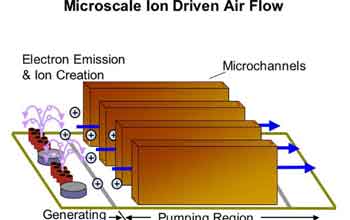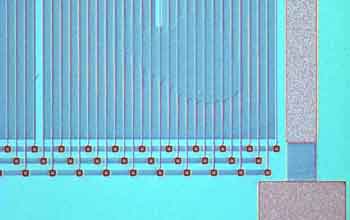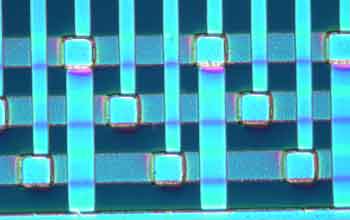All Images
News Release 04-039
A Tiny Wind to Cool the Tiniest Circuits
Researchers develop miniature cooling system that generates nanoscale breezes
This material is available primarily for archival purposes. Telephone numbers or other contact information may be out of date; please see current contact information at media contacts.

Mechanical engineers at Purdue University are developing a new type of cooling technology for computers that uses a sort of nano-lightning to create tiny wind currents. This diagram depicts one version of the design, including the carbon nanotube electrodes, represented by thin red tubes on the left, which emit electrons and make it possible to create the ionizing effects of lightning using low voltage.
Credit: Daniel J. Schlitz, Purdue School of Mechanical Engineering

Mechanical engineers at Purdue are developing a new type of computer cooling technology that uses a sort of nano-lightning to create tiny wind currents. This photo shows electrodes in a "pumping region" of the device. Clouds of ions created when electrons react with air are then attracted by these electrodes and "pumped" forward by changing the voltages in the electrodes. The researchers have demonstrated that the pumping concept works with a region of electrodes made of many series, each series containing three electrodes. The first in the series is the most positively charged, followed by an electrode that has a less-positive charge and then a third electrode that is negative. The voltages are rapidly switched from one electrode to the next in such a way that the clouds of ions move forward. The electrode voltages are switched roughly a million times a second, pushing the ion clouds forward and producing a cooling breeze.
Credit: Daniel J. Schlitz, Purdue School of Mechanical Engineering

This is a close-up photo of electrodes in the "pumping region" of a new type of cooling technology for computers being developed by mechanical engineers at Purdue. The concept is to use a sort of nano-lightning to create tiny wind currents. Clouds of ions created when electrons react with air are then attracted by these electrodes and "pumped" forward by changing the voltages in the electrodes. The researchers have demonstrated that the pumping concept works with a region of electrodes made of many series, each series containing three electrodes. The first in the series is the most positively charged, followed by an electrode that has a less-positive charge and then a third electrode that is negative. The voltages are rapidly switched from one electrode to the next in such a way that the clouds of ions move forward. The electrode voltages are switched roughly a million times a second, pushing the ion clouds forward and producing a cooling breeze.
Credit: Daniel J. Schlitz, Purdue University School of Mechanical Engineering


